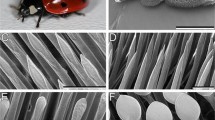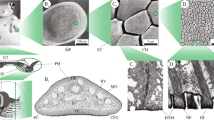Abstract
The morphology, ultrastrucure, effective elastic modulus, and adhesive properties of two different smooth-type attachment pads were studied in two orthopteran species. Tettigonia viridissima (Ensifera) and Locusta migratoria (Caelifera) have a similar structural organization of their attachment pads. They both possess a flexible exocuticle, where the cuticular fibrils are fused into relatively large rods oriented at an angle to the surface. The compliant material of the pad contributes to the contact formation with the substrate. However, the pad material structure was found to be different in these two species. L. migratoria pads bear a thick sub-superficial layer, as well as a higher density of rods. The indentation experiments showed a higher effective elastic modulus and a lower work of adhesion for L. migratoria pads. When the indentations were made at different depths, a higher effective elastic modulus was revealed at lower indentation depths in both species. This effect is explained by the higher stiffness of the superficial pad layer. The obtained results demonstrate a clear correlation between density of the fibres, thickness of the superficial layer, compliance of the pad, and its adhesive properties. Such material structures and properties may be dependent on the preferred environment of each species.







Similar content being viewed by others
References
Andersen SO, Weis-Fogh T (1964) Resilin, a rubber-like protein in arthropod cuticle. Adv Insect Physiol 2:1–65
Arzt E, Gorb SN, Spolenak R (2003) From micro to nano contacts in biological attachment devices. PNAS 100:10603–10606
Autumn K, Sitti M, Peattie A, Hansen W, Sponberg S, Liang YA, Kenny T, Fearing R, Israelachvili J, Full RJ (2002) Evidence for van der Waals adhesion in gecko setae. PNAS 99:12252–12256
Beutel RG, Gorb SN (2001) Ultrastructure of attachment specializations of hexapods (Arthropoda): evolutionary patterns inferred from a revised ordinal phylogeny. J Zoolog Syst Evol Res 39:177–207
Carbone G, Mangialardi L, Persson BNJ (2004) Adhesion between a thin elastic plate and a hard randomly rough substrate. Phys Rev B 70:125407
Dai Z, Gorb SN, Schwarz U (2002) Roughness-dependent friction force of the tarsal claw system in the beetle Pachnoda marginata (Coleoptera, Scarabaeidae). J Exp Biol 205:2479–2488
Enders S, Barbakadse N, Gorb SN, Arzt E (2004) Exploring biological surfaces by nanoindentation. J Mater Res 19:880–887
Federle W, Endlein T (2004) Locomotion and adhesion: dynamic control of adhesive surface contact in ants. Arthropod Struct Dev 33:67–75
Frantsevich L, Gorb S (2004) Structure and mechanics of the tarsal chain in the hornet, Vespa crabro (Hymenoptera: Vespidae): implications on the attachment mechanism. Arthropod Struct Dev 33:77–89
Gorb SN (1999) Serial elastic elements in the damselfly wing: mobile vein joints contain resilin. Naturwissenschaften 86:552–555
Gorb SN (2001) Attachment devices of insect cuticle. Kluwer Academic Publishers, Dordrecht, The Netherlands
Gorb SN, Beutel RG (2001) Evolution of locomotory attachment pads of hexapods. Naturwissenschaften 88:530–534
Gorb SN, Jiao Y, Scherge M (2000) Ultrastructural and mechanical properties of attachment pads in Tettigonia viridissima (Orthoptera, Tettigoniidae). J Comp Physiol A 186:821–831
Gorb S, Gorb E, Kastner V (2001) Scale effects on the attachment pads and friction forces in syrphid flies (Diptera, Syrphidae). J Exp Biol 204:1421–1431
Hepburn HR (1985) Structure of the integument. In: Kerkut GA, Gilbert LI (eds) Comprehensive insect physiology, biochemistry, and pharmacology. Pergamon, Oxford, pp. 1–58
Hertz H (1881) Über den Kontakt elastischer Körper. J Reine Angew Math 92:156–171
Jiao Y, Gorb SN, Scherge M (2000) Adhesion measured on the attachment pads of Tettigonia viridissima (Orthoptera, Insecta). J Exp Biol 203:1887–1895
Johnson KL (1985) Contact mechanics. Cambridge University Press, Cambridge
Johnson KL, Kendall K, Roberts AD (1971) Surface energy and the contact of elastic solids. Proc R Soc Lond A 324:301–313
Kohane M, Daugela A, Kutomi H, Charlson L, Wyrobek A, Wyrobek J (2003) Nanoscale in vivo evaluation of the stiffness of Drosophila melanogaster integument during development. J Biomed Mater Res A 66:633–642
Neville AC (1975) Biology of arthropod cuticle. Springer, Berlin Heidelberg New York
Niederegger S, Gorb SN, Jiao Y (2002) Contact behaviour of tenant setae in attachment pads of the blowfly Calliphora vicina (Diptera, Calliphoridae). J Comp Physiol A 187:961–970
Persson BNJ (2003) On the mechanism of adhesion in biological systems. J Chem Phys 118:7614–7621
Persson BNJ, Gorb S (2003) The effect of surface roughness on the adhesion of elastic plates with application to biological systems. J Chem Phys 119:11437–11444
Scherge M, Gorb SN (2000) Biological micro- and nanotribology. Nature’s solutions. Springer, Berlin Heidelberg New York
Slifer EH (1950) Vulnerable areas on the surface of the tarsus and pretarsus of the grasshopper (Acrididae, Orthoptera) with special reference to the arolium. Ann Entomol Soc Am 43:173–188
Spurr AR (1969) A low-viscosity epoxy resin embedding medium for electron microscopy. J Ultrastruct Res 26:31–43
Vincent JFV, Wegst UGK (2004) Design and mechanical properties of insect cuticle. Arthropod Struct Dev 33:189–199
Vötsch W, Nicholson G, Müller R, Stierhof Y-D, Gorb S, Schwarz U (2002) Chemical composition of the attachment pad secretion of the locust Locusta migratoria. Insect Biochem Mol Biol 32:1605–1613
Acknowledgments
The authors are grateful to Ms Koch (Wilhelma Zoo Insectarium, Stuttgart, Germany) for supply of insects for this study. Dr S. Enders and Dr N. Barbakadse (Max Planck Institute for Metals Research, Stuttgart, Germany) introduced and guided the first author in the nano-indentation technique. This study was partly supported by the project BioFuture 0311851 (Federal Ministry of Education and Science, BMBF, Germany) to SNG.
Author information
Authors and Affiliations
Corresponding author
Rights and permissions
About this article
Cite this article
Perez Goodwyn, P., Peressadko, A., Schwarz, H. et al. Material structure, stiffness, and adhesion: why attachment pads of the grasshopper (Tettigonia viridissima) adhere more strongly than those of the locust (Locusta migratoria) (Insecta: Orthoptera). J Comp Physiol A 192, 1233–1243 (2006). https://doi.org/10.1007/s00359-006-0156-z
Received:
Revised:
Accepted:
Published:
Issue Date:
DOI: https://doi.org/10.1007/s00359-006-0156-z




